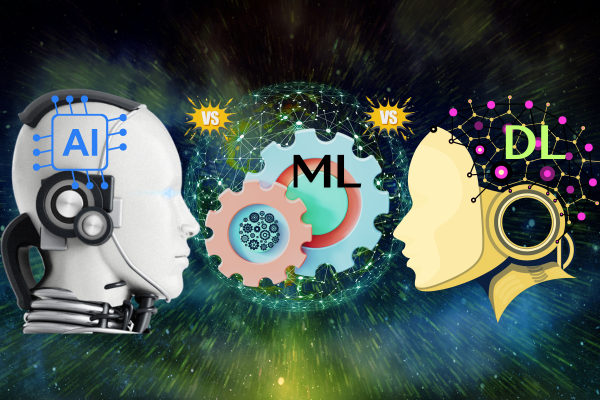Artificial Intelligence, Machine Learning, Deep Learning – these technologies have become the most talked-about topics in the world today because most companies have used these technologies to create cutting-edge machines and applications. We live in a world that is increasingly dominated by sophisticated systems.
INTRODUCTION
Machine Learning, Artificial Intelligence, Deep Learning – these technologies have become the most talked-about topics in the world today. Most companies have used these technologies to create cutting-edge machines and applications. We live in a world that is increasingly dominated by sophisticated systems.
Many people struggle to understand the distinction between these topics. This blog will help you get a clear idea about AI, machine learning, and deep learning, and how they differ from each other.
Whether you are a student, a businessperson, or a homemaker, understanding the concepts of these topics is essential in this digital age.
Before we learn about these topics, let’s see what technologically savvy people have to say about these technologies.
“I believe AI is a serious threat to the future of humanity, and could even lead to destruction if we are not careful. That is why I support strict controls on AI. Transparent development is essential to ensure that AI helps humanity rather than harming it.” – Elon Musk, Technology Entrepreneur and Investor.
“Artificial intelligence, deep learning, machine learning—even if you’re not nationally interested, if you don’t understand them—learn them. Because otherwise, you’ll be a dinosaur in 3 years.” – Mark Cuban, American entrepreneur and television personality.
“In deep learning, the algorithms we use today are versions of the algorithms that were built in the 1980s and 1990s.” – Geoffrey Hinton, Godfather of Deep Learning.
Here is an illustration that explains the basic differences between Artificial Intelligence, Machine Learning and Deep Learning in a simple way.
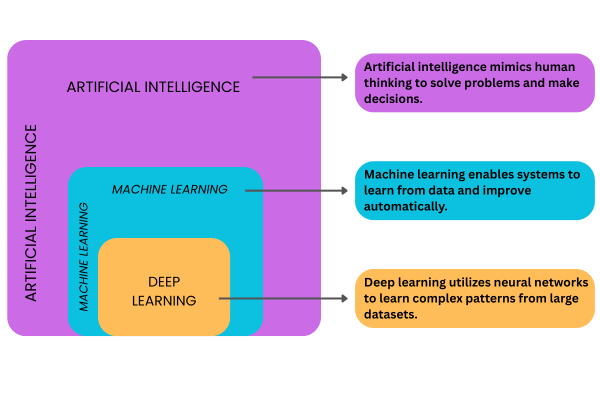
Artificial Intelligence (AI) means making computers smart like humans.
Machine Learning (ML) is how computers learn from examples.
Deep Learning (DL) is a method that enables computers to learn using brain-like structures called neural networks.
Let’s look at each of these in more detail.
What is Artificial Intelligence (AI)?
Artificial intelligence (AI) is the process of equipping machines with the ability to process data and imitate human intelligence. Primarily, AI creates autonomous machines that can think and act like humans. These machines can replicate human behavior and can understand and solve problems. Most AI systems imitate natural intelligence to solve complex problems.
Let’s have a look at an example of an AI-driven product – Google Nest Audio (Smart Speaker).
If you notice in the image below, a person wants to know which is the coldest place on earth. The person’s voice is first converted into a machine-readable format. The formatted data is then fed into the Google Assistant system for processing and analysis. Finally, the Google Assistant returns the desired voice output through Google Nest Audio.
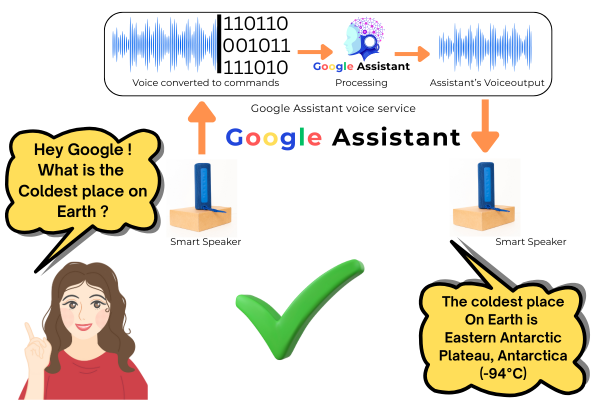
Google Nest Audio is a smart speaker that uses Google Assistant, a virtual AI technology developed by Google. Google Assistant is capable of playing audiobooks, playing music, delivering news, and providing real-time information such as weather, sports, and traffic reports.
Now that you have been given a simple introduction to the basics of Artificial Intelligence, let’s have a look at its different types.
Types of Artificial Intelligence
Self-awareness :
These systems are designed and built in such a way that they are aware of themselves. They understand their internal state, predict the feelings of others and act accordingly.
Limited memory :
These systems refer to the past and add information over time. The referred information is short-lived.
Reactive machines :
These systems react. They do not use past experience to make new decisions.
Some Applications of Artificial Intelligence :
- Language Translation, such as Google Translate
- Self-driving vehicles such as Google’s Waymo
- AI Robots such as Sophia and Aibo
- Speech Recognition applications like OK Google or Apple’s Siri.
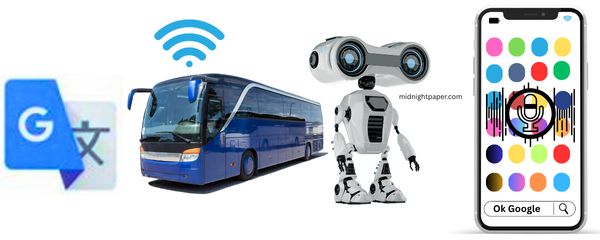
What is Machine Learning (ML)?
Machine learning is a branch of computer science that utilizes computer algorithms and analytics to develop models that can address various business problems.
Andrew Ng (Computer Scientist, AI Researcher, Educator), Machine learning is a way of making computers work explicitly. It is a system that learns from data to make decisions, and automatically improves as it gains more experience.
Aurélien Géron’s book on machine learning says, “Machine learning is the process of teaching computers to learn from data and make decisions without being explicitly programmed. It enables smart applications in areas such as vision, speech, and prediction, helping to automatically improve systems by finding patterns.”
You may know what machine learning is, but how does it work?
How does machine learning work?
Machine learning accesses large amounts of data and learns from it to make predictions. Below is a diagram that shows how a machine learns from data.
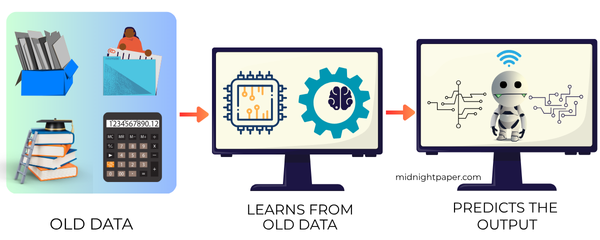
Now, let’s examine the different types of machine learning methods.
Types of Machine Learning
Machine learning can be divided into three parts.
1. Supervised Learning:
Supervised learning involves training a machine using labeled data, where both inputs and outputs are provided. The computer algorithm learns to map input values to corresponding output values.It is widely used in real-world applications such as classification, regression, and forecasting problems.
Below is an example of a supervised learning method.
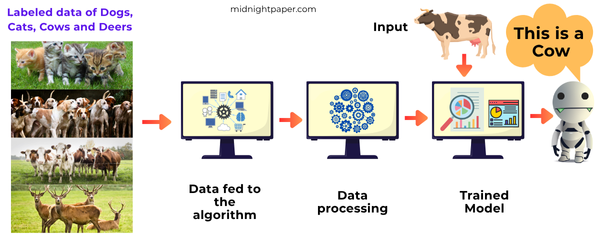
Unsupervised Learning:
Unsupervised learning deals with unlabeled data. This algorithm helps identify patterns, structures, or relationships in data without requiring prior labels. It is particularly used for clustering, dimensionality reduction, and anomaly detection, which helps in understanding the underlying structure and organization of complex datasets in various fields such as biology.
Here is an example of an unsupervised learning method that trains a model using unlabeled data. The data contains pictures of various types of vehicles, and the model intends to classify each type of vehicle.
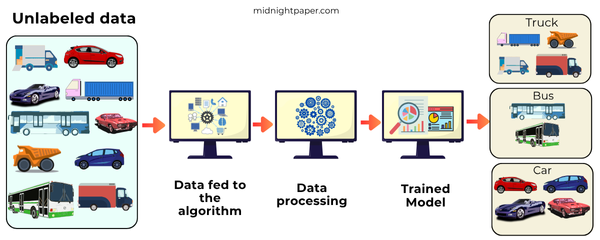
Reinforcement Learning:
It is based on learning through interaction with the environment. An agent performs actions and receives feedback in the form of rewards or penalties. Its goal is to maximize long-term rewards. It is mainly used in robotics, gaming, and real-time decision-making.
Below is an example of a Reinforcement Learning method.
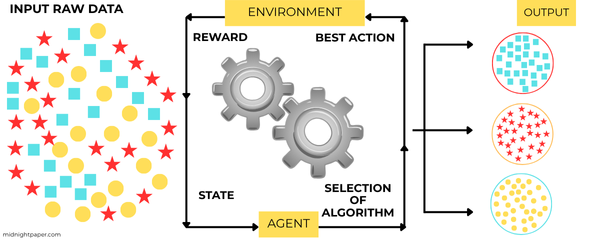
Some Applications of Machine Learning :

- Image and Speech Recognition
- Natural Language Processing (NLP)
- Healthcare and Medical Diagnosis
- Recommendation Systems
- Financial Services
- Driver Assistance Systems
- Marketing and Customer Segmentation
- Cybersecurity
- Spam Filtering
What is Deep Learning?
Deep learning is a subset of machine learning that uses artificial neural networks to mimic how the human brain works. This system helps computers make smart decisions. Instead of being told exactly what to do, the system improves its performance by learning patterns from systematic examples.
Deep learning is particularly effective at handling complex tasks such as language translation, image recognition, speech processing, and self-driving cars.
The more data this system is given, the more accurate it will be. This strengthens the technologies used in our daily digital lives.
The main difference between deep learning and machine learning is that machine learning algorithms typically require structured data, but deep learning networks operate on multiple layers of artificial neural networks.
Here is an example of a neural network that uses a large set of unlabeled data. Neural networks have been used effectively to detect COVID-19 by analyzing chest X-ray images. A type of neural network called a convolutional neural network (CNN) is trained on thousands of X-rays that are labeled as COVID-positive, pneumonia, or normal.

During the pandemic, such AI-based systems supported initial diagnosis and reduced the burden on radiologists by acting as a reliable second opinion in critical situations.
How does Deep Learning work?
- Deep learning uses artificial neural networks that mimic the way the human brain works.
- It learns from large amounts of data by identifying patterns and relationships.
- The data is passed through layers of “neurons” that process and transform the information.
- Each layer learns something different, such as shape, color, or objects in an image.
- Improves itself based on errors (called training).
- With enough data and training, it can make accurate decisions about new data.
Types of Deep Neural Networks
Convolutional Neural Network (CNN) :
Convolutional neural networks are designed to work with images. These systems can detect patterns, such as shapes or colors, in small parts of an image.
CNNs are used in face recognition, medical image analysis, and self-driving car functionality.
Recurrent Neural Network (RNN) :
Recurrent neural networks are specialized for processing sequential data. Unlike feedforward networks, RNNs have loops that help maintain the memory of previous inputs through hidden states.
This system makes them robust in situations where the order of inputs is important, such as time-series data, natural language processing, and where the order of inputs is important.
Generative Adversarial Network (GAN) :
Generative adversarial networks essentially consist of two neural networks, one a generator and the other a discriminator. The generator tries to generate realistic data, while the discriminator tries to find the reader between real and fake data.
Through this adversarial process, the generator becomes better at generating data that resembles the real thing.
This system is widely used to generate images, videos, music, and even synthetic data.
Deep Learning Applications :
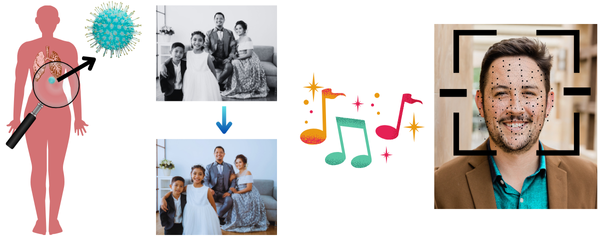
- Music Generation
- Image Generation
- Object Detection
- Image Coloring
- Cancer Tumor Detection
- Face and Emotion Detection
- Natural Language Processing (NLP)
- Speech Recognition

